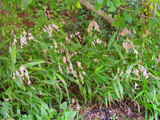Native Plants

Q. Who is Mr. Smarty Plants?
A: There are those who suspect Wildflower Center volunteers are the culpable and capable culprits. Yet, others think staff members play some, albeit small, role. You can torture us with your plant questions, but we will never reveal the Green Guru's secret identity.
Did you know you can access the Native Plant Information Network with your web-enabled smartphone?
Ask Mr. Smarty Plants is a free service provided by the staff and volunteers at the Lady Bird Johnson Wildflower Center.

rate this answer
Wednesday - August 28, 2013
From: Florence, KY
Region: Mid-Atlantic
Topic: Erosion Control, Shade Tolerant
Title: Erosion control for shady slope in Kentucky backyard
Answered by: Nan Hampton
QUESTION:
I live in northern Kentucky (near Cincinnati). I have an area in my backyard that has slope. It is next to an ash tree and is very shady. Water erosion has washed away the top soil and pretty much nothing will grow there. I have tried planting periwinkle and ferns but they haven't done well, I think because the soil is too nutrient deficient. I have tried composting with dead leaves and grass clippings but when it rains, the water washes that away too. Any suggestions?ANSWER:
The best solution may be erosion control blankets to stabilize the erosion area. The erosion-control fabric works by slowing the runoff water and allowing sediments to fall out rather than be washed away. Seeds are sown under the erosion-control material and grow up through the matting when they germinate. You can also insert plants into the soil by cutting through the matting. The roots of the plants that are growing through the erosion-control material anchor the soil to stop the erosion. If you use erosion-control blankets made of biodegrable material, they will eventually disappear leaving the plants to control the problem. You could add your dead leaves, grass clippings and, perhaps, some topsoil underneath the blanket. These blankets are available at some larger nurseries and "big box" stores. Search on the internet for locations near you. Now, here are some recommendations for native shade-loving plants to try for the area. These all can be found occurring in Boone County or in adjacent areas.
GRASS/GRASS-LIKE (Grasses and sedges have fibrous root systems that help hold soil in place.)
Carex blanda (Eastern woodland sedge)
Carex pensylvanica (Pennsylvania sedge)
Carex plantaginea (Plantainleaf sedge)
Danthonia spicata (Poverty oatgrass) will grow in the shade and poor soil. Here are photos and more information from Illinois Wildflowers.
Chasmanthium latifolium (Inland sea oats)
Sorghastrum nutans (Indiangrass)
PERENNIAL SHRUBS
Ceanothus americanus (New jersey tea) has massive, deep roots to help prevent erosion.
Heuchera americana (American alumroot) tolerates poor soil.
Gaylussacia baccata (Black huckleberry)
FERNS (There are other possibilities for ferns, but these two are good choices.)
From the Image Gallery
More Erosion Control Questions
Plants for pond, for incline and area with poor soil
April 23, 2012 - I have three plant recommendation questions for Austin, TX.
1. I have a large pond that I would like to put native aquatic plants in. What are some hardy aquatic natives I could put in? The pond ...
view the full question and answer
Plants for erosion control in arid region
September 29, 2008 - In semi arid south west (Phoenix), the drainage is managed by creating incised channels. Typically, the dirt channel can erode with even very low velocities of moving water. To reduce erosion therefor...
view the full question and answer
Can Carolina wild petunia be planted over septic tank in Nokomis FL
July 10, 2011 - Could you tell me the root depth of the Ruellia caroliniensis/ Carolina wild petunia? Trying to determine if I can plant it over septic tank.
view the full question and answer
Exposed Tree Roots in Austin
September 04, 2012 - I have a large ash tree with a lot of mud at the top of a sloping yard. I want to build a small retaining wall with the ground leveled above. This would entail covering exposed tree roots with 4-18 in...
view the full question and answer
Plants for bridge foundation erosion control in WV .
July 05, 2010 - There is a stream on my property that I must cross to get to my house from the road (stream is about 6 - 8 feet wide, with 5 to 6 foot banks). I've recently had to have the bridge repaired, and the ...
view the full question and answer
| Support the Wildflower Center by Donating Online or Becoming a Member today. |

